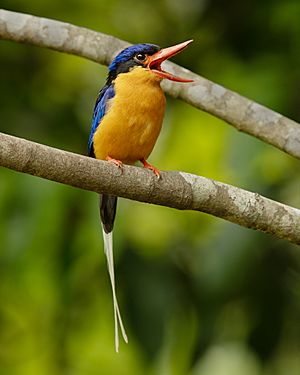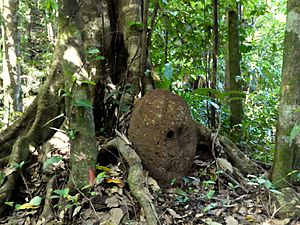Buff-breasted paradise kingfisher facts for kids
Quick facts for kids Buff-breasted paradise kingfisher |
|
|---|---|
 |
|
| Conservation status | |
| Scientific classification | |
| Genus: |
Tanysiptera
|
| Species: |
sylvia
|
The buff-breasted paradise kingfisher (Tanysiptera sylvia) is a super colorful bird. It's part of the tree kingfisher family. You can find it in Australia and New Guinea. Every November, these birds fly from New Guinea to the rainforests of North Queensland, Australia, to have their babies. Like other paradise kingfishers, it has bright feathers, a red beak, a buff-colored chest, and cool, long tail feathers that stream behind it!
Contents
About Its Name
Have you ever wondered how animals get their names? Scientists have a special way of naming and grouping living things. This is called taxonomy. The buff-breasted paradise kingfisher was first described by an English bird expert and artist named John Gould in 1850. He called it Tanysiptera sylvia. He got his information from a naturalist named John MacGillivray. The birds were found on the Cape York Peninsula in Australia.
The name Tanysiptera comes from ancient Greek words. Tanuo means 'long', and pteron means 'wing'. The word sylvia comes from a Latin word, silva, which means 'forest'. So, its name basically means 'long-winged forest bird'! For a while, people called this bird the white-tailed kingfisher. But in 1980, it became known as the buff-breasted paradise kingfisher in Australia.
Different Types
There are two main types, or subspecies, of this bird:
- T. sylvia sylvia: This type breeds in northern Queensland. It spends its winters in New Guinea.
- T. s. salvadoriana: This type breeds in southeast New Guinea. It was named after an Italian bird expert, Tommaso Salvadori.
Another bird, the black-capped paradise kingfisher, used to be thought of as a type of buff-breasted paradise kingfisher. But now it's considered its own species.
What It Looks Like
The buff-breasted paradise kingfisher is a very colorful bird. It has a big red beak and a rich, buff-orange color on its belly. Its head and outer tail feathers are blue or purple. It has black stripes around its eyes that go down to its neck. Its feet are red. The lower part of its back and its rump are white.
Its most special feature is a white patch in the middle of its upper back. Its long tail feathers can be white or blue and white. These tail feathers can look a bit different depending on where the bird lives. Younger birds look a bit different. They have brown beaks and yellowish feet. Their colors are not as bright, and they don't have the long tail feathers yet.
Size and Weight
An adult male bird is about 35 cm (14 in) long. This includes its long tail feathers, which can stick out about 13 cm (5 in) past the rest of its tail. An adult female is about 30 cm (12 in) long. Her tail feathers are shorter, sticking out about 8 cm (3 in). The total length of their tails is usually around 18 cm (7 in). Young birds have shorter tail feathers than adults. Sometimes, their tail feathers get a bit damaged near the end of the breeding season. This might happen when they go in and out of their nests. But don't worry, they grow back before the next breeding season! These birds are quite light. They weigh about 45 to 50 grams (1.6 to 1.8 oz). That's about the same as a small chocolate bar!
What It Sounds Like
Even though these birds are very colorful, they can be hard to spot in the thick rainforest. The best way to find them is by listening for their special calls. They are usually loudest at the start of the breeding season. This is when the males are finding their own areas and trying to attract a mate.
The most common call sounds like an ascending ch-kow, ch-kow or tcherwill tcherwill. They repeat this sound 4-5 times. When they call, they often flick their tails. They might also point their heads up, pull their wings down, and fluff up their white feathers. They also make a soft, descending trill sound. They use this when they are near their nest. It's thought to be a comforting sound for their mate. If they are scared, they can make loud, sudden shrieks. Baby birds in the nest make a soft, constant whirring sound.
Where It Lives
During the breeding season, from November to March, you can find the buff-breasted paradise kingfisher in the coastal areas of north-east Queensland. This includes islands in the Torres Strait and the Cape York Peninsula. They can be found as far south as Byfield. Some have even been seen on islands of the Great Barrier Reef.
These kingfishers live in lowland rainforests. They also like small areas of hill forest where there are termite mounds. They usually perch in the middle or lower parts of the trees. They come down to the ground to find food.
Its Big Trip
One type of this bird, T. s. sylvia, breeds in north-east Queensland from November to early April. After that, they fly north to New Guinea for the non-breeding season. The young birds leave about three weeks after the adults. These birds can travel between 400 and 2000 kilometers (250 to 1240 miles)! It's believed that these kingfishers travel in groups at night. Large numbers of them suddenly appear in Queensland rainforests early in the morning at the start of the breeding season.
Sadly, many birds might not make it during the 80-kilometer (50-mile) flight from New Guinea to Australia. Some have been seen drowning in sea spray or crashing into the Booby Island Lighthouse. Others arrive very, very tired. The birds that breed in New Guinea usually stay there all year round.
How It Behaves
These birds can be quite protective of their space. In New Guinea, single birds will defend their feeding areas. During the breeding season in Australia, pairs of birds will defend their territory together.
Having Babies
In Australia, these kingfishers make their nests inside small termite mounds. These mounds can be on the ground, on rotting logs, or at the bottom of a tree. Some nests have even been found in mounds attached to living trees, about 1.5 to 3 meters (5 to 10 ft) above the ground. The breeding season in Australia starts as soon as the birds arrive in early November. The termite mounds they use are usually about 40 to 70 cm (16 to 28 in) tall and 40 to 50 cm (16 to 20 in) wide. They dig an entrance hole, about 4 cm (1.6 in) wide, into the side of the mound. This hole is usually about 35 to 50 cm (14 to 20 in) from the ground.
When the birds arrive, they immediately start digging their nests. It usually takes them 3 to 4 weeks to dig a tunnel about 15 cm (6 in) long. The tunnel floor is flat and smooth, with a round room at the end. They don't use any extra nesting material inside. Birds might use the same mound in future years. But they always have to dig a new tunnel. This is because the termites usually fill in the old hole from the year before! Not all the holes they dig are used as nests. Some are left empty, but they might be used if another nest is attacked. After the young birds leave the nest, the chamber is left with lots of old feathers, waste, and food scraps. The nest room can get very hot and smelly. They choose mounds where termites are active. This might be because the termites help keep the temperature steady for the eggs. Or maybe the termites help keep the tunnel from collapsing.
The buff-breasted paradise kingfisher usually lays one set of eggs each year. They might lay a second set only if the first one fails early in the season. A set of eggs, called a clutch, usually has 3 or 4 shiny, white, round eggs. Each egg is about 22 by 25 mm (0.9 by 1.0 in). Both parents take turns sitting on the eggs to keep them warm. The eggs hatch after about 23 days. The baby birds, called chicks, leave the nest after about 25 days. They have been seen flying straight to a branch as soon as they leave the nest! On average, about 1.5 young birds successfully leave the nest per pair.
What It Eats
The buff-breasted paradise kingfisher hunts for food on the ground and in the middle to lower parts of the forest trees. It eats many different things. Its diet includes stick insects, earthworms, beetles, insect larvae, and spiders. It also eats small lizards, frogs, and snails. One bird was even seen holding a small tortoise! Both parents feed the young birds.
Dangers and Protection
Some animals like snakes and goannas might eat the eggs in the nest. A butcherbird has also been seen hunting young kingfishers. Losing their habitat in New Guinea due to land clearing could affect the birds that breed in Australia. Even though the number of these birds is slowly going down, the buff-breasted paradise kingfisher is listed as "least concern" on the IUCN Red List. This means it's not currently in danger of disappearing.
In Culture
The buff-breasted paradise kingfisher has been featured on stamps! It appeared on a 22-cent Australian stamp in 1980. It was also on a 25-toea Papua New Guinea stamp in 1981.
See also
 In Spanish: Alción colilargo silvia para niños
In Spanish: Alción colilargo silvia para niños




